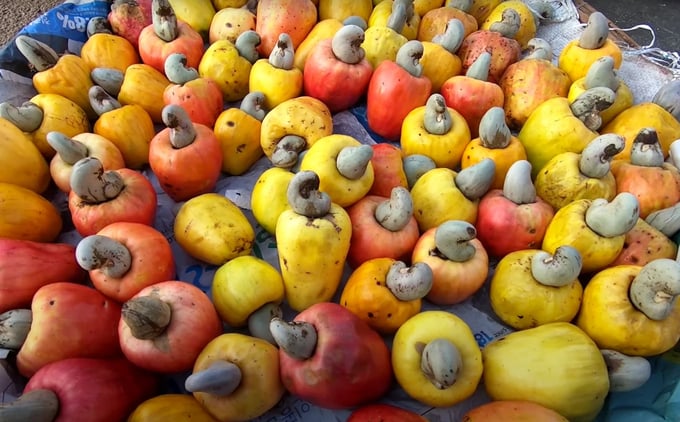May 16, 2025 | 11:48 GMT +7
May 16, 2025 | 11:48 GMT +7
Hotline: 0913.378.918
May 16, 2025 | 11:48 GMT +7
Hotline: 0913.378.918

Processing cashews for export at a factory of Long Son Joint Stock Company. Photo: Thanh Son.
According to Mrs. Nguyen Thi Hoang Thuy, Trade Counselor of Vietnam in Sweden, the increasing demand for healthy snacks and to find stable and sustainable sourcing are the leading driving forces promoting the interest in growing consumer interest in cashews in Europe, including the Nordic countries.
Nuts, including cashews, are highly valued by European consumers. Consumption of nuts is expected to grow most in the snacking segment. In major consuming countries, cashews are considered a healthier alternative to other salty snacks such as crisps and are healthier than peanuts.
With busy lifestyles, European consumers are replacing traditional lunch breaks with healthy snacks. Among them, nuts are an important ingredient. There is growing interest in vegan diets, the consumption of salty nuts (considered a healthy snack), nut spreads (such as cashew butter), and the use of manufactured beverages from edible nuts (cashew milk) is on the rise. Nuts help consumers meet their protein needs and address lactose intolerance when animal protein is unavailable.

Vietnam's exported cashews, which are not roasted or fried, are used directly by many European consumers. Photo: Thanh Son.
Cashew nuts are increasingly being used in Europe. Mrs. Nguyen Thi Hoang Thuy said that the most significant segment using cashew nuts in Europe is the snack segment. About 90% of imported cashew nuts in Europe are sold as snacks, mainly salty roasted. Cashew kernels are also increasingly used as raw materials in the food processing industry.
For some time now, the saltiest snack in Europe has been crisps. But nuts (including cashews) are increasingly consumed and considered healthier than potato chips.
In the snacks segment, two different trends influence cashew consumption in Europe. The first is to develop different roasted flavors to diversify products and suit the distinct taste preferences of consumers. The second trend is the growing availability of unsalted and unroasted cashews as a healthier alternative to salty snacks.
In addition to being used as snacks, cashews are also becoming an important ingredient in many functional food products and health foods, such as breakfast cereals, cashew butter, cashew milk, cashew yogurt, cashew cheese, cashew protein snacks, fruit and nut bars, and chocolate products with cashews... In addition to food industry products, the use of cashews in home cooking as an ingredient in salads and meals is also increasing.

Demand for cashew nuts in Europe, China... is increasing because this type of nut is good for health. Photo: Thanh Son.
The pastry industry uses cashews to spread on cookies and cakes. Cashew spread is a new product in some European markets and is promoted as a healthier alternative to peanut butter. In addition, cashew butter is mixed with other ingredients to give consumers a more flavorful product.
The breakfast cereal industry is launching new nut-rich granola products, which often use cashews. Protein bars and fruit seeds are increasingly offered as an alternative to sugary snacks and chocolate. Cashews are often used as an ingredient in such products as a source of plant protein.
Also, according to Mrs. Nguyen Thi Hoang Thuy, the ingredient segment in food processing accounts for about 10% of the European cashew market. This food processing segment is expected to increase its market share in the next few years.
In the segment using cashew ingredients, the confectionery industry mainly uses cashew flakes and chips to produce chocolate snacks. In addition, chocolate-coated whole cashews are increasingly being offered as a new product after the success of chocolate-coated almonds in some European markets.

A cashew garden in Bu Gia Map district, Binh Phuoc. Photo: Thanh Son.
Vegan milk uses cashews to produce cashew milk, yogurt, and vegan cheese. Other segments where cashews are used include ready meals and sauces, such as pesto, where cashews are used as a substitute for more expensive pine nuts.
According to the Vietnam Trade Office in Sweden, European traders seek sustainable sources of nuts. Sustainability in the edible nuts trade was once used to target niche markets (such as FairTrade). Still, sustainability claims and certifications are among the main trends in the mass market. In 2020, the EU established an official policy called the European Green Deal, including farm-to-fork and biodiversity strategies. Both policies affect food production and trade. Aspects of the European Green Deal related to sourcing cashews and other nuts from developing countries are reducing pesticide use, increasing organic production, and switching to sustainable packaging materials.
Translated by Tuan Huy

(VAN) Japan's efforts to lower the price of rice through the release of its stockpile may finally be making some progress, albeit at a snail's pace.

(VAN) U.S. tariffs are not only a 'shock', but also an opportunity for Vietnamese businesses to renew their mindset toward comprehensive development.

(VAN) As Bac Giang lychee enters the harvest season, Minister Do Duc Duy expects that the fruit will contribute greatly to agricultural exports due to standardized production and deep processing.

(VAN) Consumers have shown a preference for free-range eggs, but those farming systems are more vulnerable to biosecurity risks like bird flu.
/2025/05/09/5701-1-184335_301.jpg)
(VAN) Vietnam’s eel exports nearly doubled thanks to a mud-free farming model, opening up new prospects while still facing numerous barriers related to international standards.

(VAN) Minister Do Duc Duy warned that if production is not professionalized and supply chains are not transparent, the U.S. market could become a growth bottleneck.

(VAN) Delegating surveillance responsibilities to local authorities is a cost-saving and efficiency-boosting measure that removes a key bottleneck for enterprises, according to Director General Duong Tat Thang.